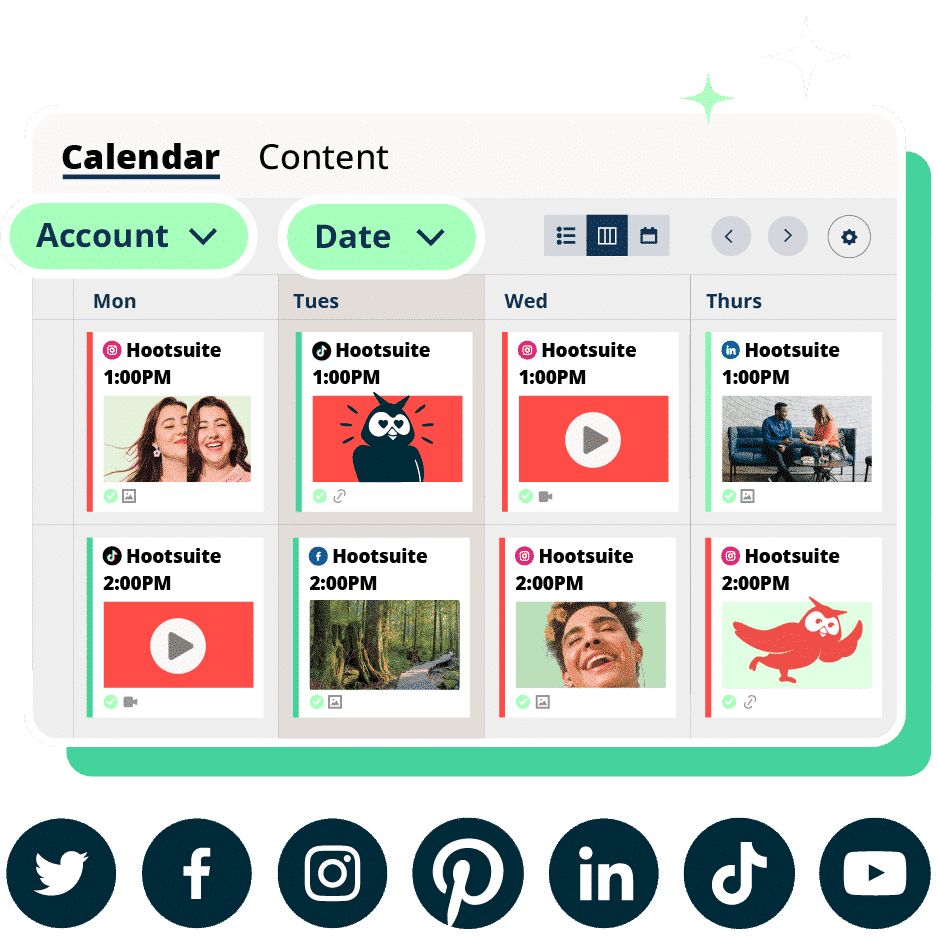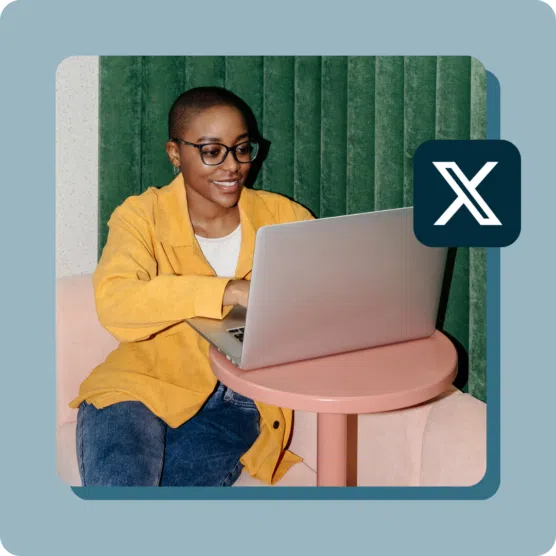Did you know that X (formerly known as Twitter) ads can reach a potential audience of 535 million people? Not too shabby of a crowd.
In 2024, X is changing advertising by using AI machine learning to improve targeting. Resulting in 10% more click-throughs and 16% more conversions on average.
Keep reading to find out the newest updates in X ads for 2024. Learn how to leverage Twitter effectively and how to start your first Twitter ads campaign today.
Bonus: Grow your X (Twitter) following fast with a free 30-day workbook that will help you establish a marketing routine and track your growth, so you can show your boss real results after one month.
What are X (Twitter) ads?
Twitter ads are how brands promote their products and services across Twitter. There are many types of Twitter ads with different goals and options to fit any business size and budget.
Twitter offers advertising options like sponsored content, promoted posts, trends, and multiple media formats. These formats include video, image, carousel, text, hashtag ads, and more.
Types of X (Twitter) ads
X ad formats
Twitter vertical video ads
Vertical video ads are full-screen videos that appear between regular vertical videos when users swipe through them, similar to TikTok.
They are currently the fastest-growing format on X and account for about 20% of all time spent on X.
You can also include a call-to-action button linking to your website or app.

Source: @ilmakiage
Twitter Promoted ads
Image ads
Image ads are a single photo and look identical to organic posts except for the small “Ad” label at the top right. You can create an image ad from scratch or turn an existing organic image post into an ad.

Source: @Propertee
Video ads
Twitter video ads are videos that can be square or landscape format. Square format is 1:1 and landscape format is 16:9. This means you can use YouTube videos for Twitter ads without any issues.

Source: @EVject
Carousel ads
Twitter carousel ads can feature up to six images, videos, or a mix of both. If desired, each slide can link to a unique URL.

Source: @AirVoelCPAP
Text ads
Promoted Twitter text ads offer all the elements of a standard post and are the easiest way to get started with ads. For instance, you can either create text ads from scratch or promote existing organic content.

Source: @Aytekintank
Amplify ads
Amplify pre-roll ads
Amplify Pre-roll ads play before an organic video starts, and viewers can choose to skip after six seconds.
X’s Amplify Publisher Program matches your video with relevant creators who have a good audience fit and align with your brand.
In return, publishers who opt into the program receive a portion of ad revenue. This program is similar to the YouTube Partner Program.
Amplify Sponsorships ads
Twitter Amplify Sponsorship ads represent a direct relationship between an X creator and a brand. Some examples are when a brand asks for permission to use a creator’s video in an ad. Another example is when a brand pays a creator to make a video specifically for them.
In addition, Amplify Sponsorship video ads also offer extra features to generate engagement, including an auto-reply DM, Q&A format, and the ability for brands to promote sponsored videos.
This post exemplifies how a brand could work with a publisher. (Although it doesn’t appear to be sponsored by Arc, it represents what a sponsorship could look like.)
Twitter Takeover ads
Timeline Takeover ads
Twitter Timeline Takeover ads give you great exposure. As a result, your ad will be the first thing an X user sees when they open the app. Plus, Timeline Takeover ads can be any format X offers and run for one day.
X claims using Timeline Takeover ads during a campaign boosts campaign awareness by 300% and ad recall by 300%.

Source: X
Trend Takeover ads
Twitter Trend Takeover ads can be found on the X homepage in the “What’s Happening” section and on the Explore tab. Trend Takeover ads are tied to a trending hashtag and include a “Promoted by” label.
Trend Takeover ads include a hashtag, a description (up to 70 characters), and an image, video, or GIF optionally.

X Live ads
Brands and/or Premium subscribers must be verified to access live video capabilities through X’s Media Studio dashboard. As a result, you can also use Media Studio to cut clips from previous live videos to use in organic posts or X ads.

Source: @IGN
Twitter Dynamic Product ads
Thanks to X’s advanced targeting, Twitter Dynamic Product ads automatically show the product someone is most likely to buy from you. You must add a catalogue in X Shopping Manager to use Dynamic Product ads.
Twitter Collection ads
You can feature up to six products in a carousel Collection ad. Alternatively, you can showcase one product with a larger hero image and different angles. This allows for a more detailed view of the product.

Source: X
X Ad features
App cards
App cards add a clickable link to Google Play or Apple App Store pages. For instance, if a user already has your app, the button can open it on their device instead.

Source: @TheScore
Website cards
Similar to app cards, add a clickable button to image or video ads linking to any website or landing page.
Branded hashtag ads
Branded X hashtag ads consist of a hashtag plus an emoji or custom icon chosen by the advertiser. You can choose up to five emojis for a single branded hashtag. After the ad ends, the hashtag becomes text-only.
In this example, #ACMs is the branded hashtag with the award emoji.
Branded notifications
X Branded Notifications opts users into receiving either a single or multiple notifications about an event, product launch, or other topic.
First, create the autoresponder trigger by liking a post or using a specific word in a comment. Users who do this action will get the notification ad as an in-app message.

Source: X
X ad objectives
Twitter optimizes ad campaigns around an objective. The objective also determines how you’re charged for the campaign. You only pay for actions related to the goal.
In an app install campaign, you only pay when someone clicks on your ad and goes to the app store. You don’t pay for someone seeing the ad and scrolling past it.
Awareness
The awareness objective is about getting the most reach, a.k.a., the most eyes on your ad. Choose this objective for brand awareness goals or as part of a larger campaign.
When to use: To reach a broad range of X users and drive discovery.
Consideration
Twitter’s consideration category includes these sub-objectives:
- Video views
- Pre-roll views
- App installs
- Website traffic
- Engagement
This objective works best for an audience looking for information on a topic or a product to meet a specific need. Twitter shows consideration ads to users more likely to watch or engage with them.
When to use: Target people from a specific audience.
Conversion
The conversion category has two sub-objectives:
- App re-engagements
- Website conversions
Conversions are designed to get you more conversions (obviously), including website traffic, app installs, purchases, or leads. Thanks to conversion tracking in X Pixel, ad performance is enhanced over time from real purchase data.
When to use: Sell more products or services and/or re-engage previous customers or visitors.
X (formerly Twitter) ad specs
Twitter vertical video ad specs
- Display size: 1080px x 1920px
- Aspect ratio: 9:16
- Maximum video length: 2:20 (X recommends 15 seconds or less)
- File type: MP4 or MOV
- Frame rate: 29.97fps or 30fps recommended, up to 60fps
- Video codec: H264 4:2:0
- Audio codec: AAC LC (low complexity)
- Maximum file size: Under 30mb recommended, up to 1GB
- Ad copy: Up to 280 characters
- Thumbnail image: PNG or JPG, sized to match video dimensions, maximum 5mb
Twitter Amplify pre-roll ad specs
- Display size: 1200px x 1200px or 1920px x 1080px
- Aspect ratio: 1:1 or 16:9
- Maximum video length: 2:20 (X recommends 15 seconds or less)
- File type: MP4 or MOV
- Frame rate: 29.97fps or 30fps recommended, up to 60fps
- Video codec: H264 4:2:0
- Audio codec: AAC LC
- Maximum file size: Under 30mb recommended, up to 1GB
- Ad copy: Up to 280 characters
- Thumbnail image: PNG or JPG, sized to match video dimensions, maximum 5mb
Twitter Amplify Sponsorships ad specs
- Display size: 1200px x 1200px or 1920px x 1080px
- Aspect ratio: 1:1 or 16:9
- Maximum video length: 2:20 (X recommends 15 seconds or less)
- File type: MP4 or MOV
- Frame rate: 29.97fps or 30fps recommended, up to 60fps
- Video codec: H264 4:2:0
- Audio codec: AAC LC
- Maximum file size: Under 30mb recommended, up to 1GB
- Thumbnail image: PNG or JPG, sized to match video dimensions, maximum 5mb
Twitter promoted video ad specs
- Display size: 1200px x 1200px or 1920px x 1080px
- Aspect ratio: 1:1 or 16:9
- Maximum video length: 2:20 (X recommends 15 seconds or less)
- File type: MP4 or MOV
- Frame rate: 29.97fps or 30fps recommended, up to 60fps
- Video codec: H264 4:2:0
- Audio codec: AAC LC
- Maximum file size: Under 30mb recommended, up to 1GB
- Ad copy: Up to 280 characters
- Thumbnail image: PNG or JPG, sized to match video dimensions, maximum 5mb
Twitter promoted image ad specs
- Display size: 1200px x 1200px or 1200px x 628px
- Aspect ratio: 1:1 or 1.91:1
- File type: PNG or JPG
- Maximum file size: 5mb
- Ad copy: Up to 280 characters
Twitter promoted text ad specs
- Ad copy: Up to 280 characters. Links use 23 characters.
Twitter promoted carousel video ad specs
If combining images and videos in the same carousel ad, all assets must use a 1:1 aspect ratio.
- Display size: 800px x 800px or 800px x 450px
- Aspect ratio: 1:1 or 16:9
- Number of slides: Between 2-6
- Maximum video length: 2:20 (X recommends 15 seconds or less)
- File type: MP4 or MOV
- Frame rate: 29.97fps or 30fps recommended, up to 60fps
- Video codec: H264 4:2:0
- Audio codec: AAC LC
- Maximum file size: Under 30mb recommended, up to 1GB
- Ad copy: Up to 280 characters per carousel
- Website title: Up to 70 characters per carousel
- Website description: Up to two lines. X recommends 50 characters or less to minimize truncating.
Twitter promoted carousel image ad specs
- Display size: 800px x 800px or 800px x 418px
- Aspect ratio: 1:1 or 1.91:1
- Number of slides: Between 2-6
- File type: PNG or JPG
- Maximum file size: 5mb each carousel
- Ad copy: Up to 280 characters per carousel
- Website title: Up to 70 characters per carousel
- Website description: Up to two lines. X recommends 50 characters or less to minimize truncating.
Twitter Timeline Takeover ad specs
Ad specs vary by format. Timeline Takeover ads can be video, image, carousel, X Live, Promoted text posts, Branded Hashtags, or Branded Notifications.
Twitter Trend Takeover ad specs
- Ad hashtag: Must include a hashtag (maximum 20 characters)
- Ad copy: Up to 70 characters
- Ad visuals: 3-6 images, videos, or GIFs that represent this trend
- Specs identical to the video and/or image specs for other X ad formats.
- Aspect ratio: 16:9
X Live ad specs
Video streaming specs may vary depending on your equipment and software, but X recommends the following X Live stream settings:
- Display size: 1280px x 720px (recommended), 1920px x 1080px
- Frame rate: 30fps recommended, up to 60fps
- Video codec: H.264
- Video bitrate: 9Mbps recommended, up to 12Mbps
- Audio codec: AA-LC
- Audio bitrate: 128bps
- Supported streaming services: Restream, Golightstream, Socialive, OBS, Wirecast, Teradek, Elemental, Vmix, StreamYard, Streamlabs (others may also work)
- Event page copy: Up to 280 characters, including links.
- Timeline feed: Up to 5 hashtags or keywords to pull a feed of mentions, including those.
Twitter Dynamic Product and Collection ad specs
To use Twitter (X) Dynamic Product and Collection ads, you must install X Pixel or Conversion API first. Then, add your product catalog to X Shopping Manager.
Individual ad specs vary by format (e.g. image, video, carousel, etc).
Twitter Branded hashtags ad specs
- Ad copy: Up to 5 hashtags associated with an emoji
- Max mentions: Each hashtag can have up to 250 mentions across X within last 30 days
- Emoji size: 72px x 72px
- Design recommendations: Simple emoji that can be easily viewed at a 16px x 16px size and looks good on dark or light backgrounds
Twitter Branded notifications ad specs
Advertisers manage the setup of Branded Notification ads in Arrow, a third-party X partner. Ad sizing and other specs depend on the format chosen. You must choose a trigger to opt people in; most brands ask users to like the post or leave a specific word or emoji in a comment.
How much do X (Twitter) ads cost?
Twitter ads budget
Asking how much Twitter ads cost is like asking what the currency exchange rate is: it varies.
That said, a survey by WebFX reports that the average Twitter ad costs between $0.26 and $0.50, and the average cost per follow ranges from $1.01 to $2.00.
No matter what your ads budget is, you’re always in control with three ways to manage it:
- Daily budget: The total amount X can spend per day on ads. Can be set either at the ad group or campaign level, depending on your settings.
- Total campaign budget: Often called “lifetime budget,” on other platforms, you set a maximum budget for a campaign.
- Ad groups budget: Define the maximum spend for an ad group inside a campaign. Each ad group can have its own budget with X’s default settings.
Alternatively, for a simpler experience, use X’s Campaign Budget Optimization. Just set a daily budget for your campaign and X will allocate it to the top-performing ad groups for you.
When setting your budget, remember that you only pay for actions directly related to your campaign objective. For Reach objective campaigns, you only pay for impressions. Moreover, you don’t pay any extra when someone likes, comments, or even clicks on your ad. Likewise, for a Website Traffic objective campaign, you only pay for clicks and nothing else.
Twitter ads auction
Twitter ads use an auction format: you bid against other advertisers to “win” the same audience. For example, if you want to reach software developers, your ad will compete with other ads targeting software developers.
To win Twitter ad auctions, there are three bidding strategies to choose from:
- Automatic bidding: Optimizes your campaign to achieve the best campaign results within your budget, without requiring detailed set-up.
- Maximum bidding: You set the highest price per action you’re willing to pay to win the placement.
- Target bidding: Set a daily spend target and X will attempt to get you the best results for a consistent daily average spend.
Winning an auction isn’t only about price. X’s ad algorithm considers the choices you’ve made, like targeting software developers in a specific country and your ad quality score. It uses this information to optimize your ad campaign for better results.
Three factors make up your ad quality score:
- Resonance: Are people engaging with your ad (clicks, likes, reposts, comments, etc)?
- Relevance: Is your audience interested in your ad topic and content?
- Recency: Is your ad recent? The X algorithm favors fresh content.

Source: X
Twitter ads targeting
Other factors contribute to the overall cost of X ads, too, such as how many other brands compete for the same audience and the size of the audience you’re trying to reach.
As for managing the size of your audience, there are two targeting options:
- Additive targeting: Define multiple interests or demographics that function independently of each other. For example, people who like cats, dogs, or iguanas but don’t have to like all three.
- Restrictive targeting: A user must meet all your criteria, such as liking cats, dogs, and iguanas.
To succeed with X ads, start by making great content for a high-quality score. Then, try different budgets, targeting options, and settings as you go.
How does X (Twitter) ad revenue sharing work?
Eligible X users can earn a portion of ad revenue for ad impressions appearing in their posts’ comment sections.
To be eligible for the program, you must:
- You must be an X Premium or Verified subscriber
- Have 500+ followers
- Have 5 million+ organic impressions
- Verify your identity
How to set up an X (Twitter) ad campaign
To create a Twitter ad campaign, you can use X Ads Manager. Alternatively, you can click Promote on any organic post to turn it into an ad.

Step 1: Log in to X Ads Manager
If you haven’t already, sign up for an X Ads Account. You’ll need to fill out your country, time zone, and billing information.
Step 2: Create a campaign
In X Ads Manager, click on Create Campaign at the top right.

Step 3: Choose your campaign type
For beginners, we recommend the Simple mode. X’s automated ad targeting tools will likely bring you the best results.
More experienced advertisers who prefer granular targeting control should choose Advanced.

Step 4: Choose an objective
In Simple mode, you can choose from four objectives: Reach, Engagements, Traffic, or Keywords.

In Advanced mode, you can choose more refined objectives.

Step 5: Create your ad
If you choose Simple mode, you’ll see a screen to create an ad right away. The specific options and fields will depend on the objective chosen.

For Advanced campaigns, you’ll first name the campaign and set a total spending cap optionally.

Clicking Next brings you to the ad group settings within this campaign.
Step 6: Confirm ad group settings (Advanced mode only)
There are several sections to fill out for each ad group within an Advanced campaign:
- Budget and schedule: A daily ad spend budget and optional total spend.
- Delivery: Define your goal, bidding strategy, and conversion tracking.
- Placements: Choose the type of ad you’re running (image, video, carousel, etc) and where it will appear on X.
- Demographics: Specify age range, language, and user based location options.
- Devices: Target users by device type, carrier, and more.
- Audiences: Choose to target only X Premium subscribers or upload an existing custom audience.
- Targeting options: Include or exclude keywords, interests, and topics. Retarget current followers and/or people you’ve previously interacted with.
- Targeting strategy: Optionally, enable optimized targeting to allow X to show your ad to users who don’t fit your previous settings if X thinks they’re likely to convert.

Step 7: Create your ad (Advanced mode only)
After setting up your ad group, create your ad.

Step 8: Review campaign settings
The last step for both Simple and Advanced campaigns is to review everything.
In Simple mode, this page includes optional demographic and targeting options since these campaigns use X’s optimized targeting.

In Advanced mode, the review page looks like this.

Step 9: Launch and measure
Click Launch campaign to begin advertising.
It’s important to measure your ad performance and test new strategies. Regularly review your impressions, results, engagement rate, and cost-per-result (CPR) in Twitter Ads Manager:

Source: X
Or, easily analyze ad performance with Advanced Analytics from Hootsuite. View organic vs. paid social media performance while accurately measuring the ROI of your social media marketing.
Watch this to learn how to track your social media analytics (plus a free template):
Bonus: Create Twitter ads with Hootsuite
Yep, there’s an even easier way to create Twitter ad campaigns: straight from your Hootsuite dashboard.
Click on Composer, then Twitter ad campaign.
Fill out your campaign settings and ad copy, then publish your X ad from Hootsuite. Couldn’t be easier, mate.

6 X ads best practices
Keep text short and sweet
Twitter allows up to 280 characters, but the best-performing ads are under 100 characters, according to Twitter.
Check out how Southern Vintage uses 72 characters and saves space by including a discount code in the call to action.
Use video
When you think of Twitter, video might not immediately come to mind. However, a whopping 80% of user sessions include watching video. So you’ll want to incorporate the format.
Not comfortable on camera? No sweat, try an animated graphic like Wealthsimple.
Keep video under 15 seconds
To grab users’ attention, concentrate on the first 1-3 seconds. Most people lose interest after 6 seconds, especially when they can skip a pre-roll video.
This video ad from Quguxe uses frequent cuts to keep the viewer watching.
Include 3-5 different ad formats per campaign
Using multiple formats in a campaign increases the likelihood of conversion by 7% and boosts campaign awareness by 20%.
Follow Riversol Skincare’s lead by creating a carousel, image, and video ad to boost conversion and reach.
Don’t use hashtags or mentions
While you may think, better reach = more hashtags, X calls them “distracting, clickable opportunities that drive people off your ad.”
In that case, less is more.
Optimize for mobile
X will show your ads where they’re most likely to succeed, but it pays to think mobile-first.
For promoted tweets or in-feed ads, media in a 1:1 ratio occupies more screen real estate on mobile. This means more people will stop scrolling.
Use vertical video in campaigns targeting mobile users.
5 Inspiring X ad examples
1. Engaging product video Twitter ad
Bitdefender’s ad uses a mix of real humans, product demos, and text overlay to showcase their product.
Why this ad works:
- Fast-paced editing holds attention
- The text reinforces key points, making it understandable without sound
2. Minimal design Twitter ad
Loosely modelled after Apple error messages, this Directive ad uses dark negative space to stop a users’ scroll.
Why this ad works:
- The black and white color palette is unique
- The error-like message cleverly captures attention and compels users to click
3. Product review Twitter ad
Nodace’s ad shows off the product well, including multiple angles while focusing on the customer experience.
Why this ad works:
- Uses real customer review to build trust
- Shows multiple features in one image (a carousel ad would work well too)
4. Start to finish Twitter ad
Varimelo’s video ad showing how to use the product (and what it can do) is always a winning idea.
Why this ad works:
- Quickly (and without words!) shows what the product does and its value
5. Bold Twitter ad
Through catchy headlines, this bright video ad commands attention right away.
Why this ad works:
- Bold colors and newspaper clipping animation stand out on the feed.
- It’s short and to the point, in under 15 seconds.
Manage your Twitter (X) account, plus organic and paid social media campaigns on all your other platforms in one easy dashboard with Hootsuite. Schedule, publish, and analyze post performance, engage your audience, run ads, and more. Try it free today.








